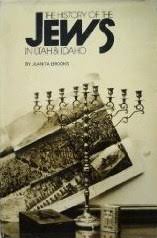Articles/Essays – Volume 09, No. 1
Judah Among the Ephriamites | Juanita Brooks, History of the Jews in Utah and Idaho
This might well be the most difficult book Juanita Brooks ever undertook. Consider the formidable problems: Though Mrs. Brooks is the scholar’s scholar of Mormonism, what can she do about the fact that the Jews had no significant part in the pioneer history of the Great Basin?
As late as 1854, when the Saints had been in Utah seven years, had built Salt Lake City in the desert and were actively colonizing the Intermountain area, there were at this time exactly two Jews in the entire Territory. Subsequently, when virtually every Mormon village had a neighborhood store operated by a Jew, these merchants were transient residents. Because of the strongly pro-Mormon curriculum of Utah schools, Jewish families either had to send their children out side for education or, as the young people approached adolescence, move away.
Thus Mrs. Brooks was faced with the task of telling the story of Mormon country through Jewish eyes, when during the pioneer period Jews were hard to find, while Jewish converts could be counted on the fingers of one hand. A formidable task indeed for the historian; but Mrs. Brooks has done her usual amazingly competent job of research to cope with it.
It was a Jew, Abraham Jonas, Grand Master of Masons in Illinois, who came to Nauvoo to install a lodge there on March 15,1842. And after the death of Joseph Smith,
Governor Thomas Ford selected Mr. Jonas to persuade the Mormons not to retaliate. Mr. Jonas’ appeal was so effective that the Mormon audience responded with a hearty “Amen.”
In Utah, the festering trouble between the Saints and the U. S. Government was brought to a head as the result of a game of cards between a Jewish convert named Levi Abrams (known as “Abraham the Jew”) and Judge W. W. Drummond, a bitterly anti-Mormon Federal appointee. The judge lost his money to the Jew, and sent his colored servant to horsewhip Abrams, who in turn swore out a warrant against Drummond. The judge was apprehended by an armed posse,
arrested and brought a prisoner to his own court, where he was subjected to ridicule and embarrassment. . . . It was such tactics as this that gave justification to Judge Drummond’s bitterness and desire for revenge.
Drummond’s report to Washington triggered off the Utah War of 1857. The forces set in motion by the altercation over the card game
grew into such power that they affected the lives of twenty-five hundred soldiers and most of the people of Utah.
An anecdote typifying Jewish canniness concerns Louis Kolitz, who ran a candy store on Main Street. Bishop Nibley sold him a load of sugar at one cent a pound, reason for the bargain price being that it had been tainted with kerosene. Kolitz soon asked Nibley if any more was available. Surprised, Nibley asked, “What did you do with the first load?”
“Made it into cough drops. They went like hot cakes.”
For those with an especial interest in Mormon history, the book provides nuggets:
—When ZCMI was formed, the only two non-LDS firms purchased for incorporation into the cooperative were owned by Jews.
—The LDS Church contributed $650 toward the erection of the first synagogue in Utah.
—The pioneer Mormons adopted the Jewish custom of seating men and women on opposite sides of the aisle in church.
—There was a Jewish colonization project in the Sevier Valley. Though it failed, out of it came the highly successful Utah Egg and Poultry Association.
—A Jewish governor of Utah, Simon Bamberger, was the first chief executive of the state to occupy the present Capitol building.
Mrs. Brooks touches rather lightly on an interesting aspect of pioneer attitudes
—the extremely strong Hebraic aspect of Mormonism at that time. In his Women of Mormondom, published in the last year of Brigham Young’s life, Edward W. Tullidge could state boldly:
The first covenant was made with Abraham and the patriarchs in the East. The greater and the everlasting covenant will restore the kingdom to Israel. That covenant has been made in the West , with these veritable children of Abraham. God has raised up children unto Abraham to fulfill the promises made to him. This is Mormonism. . . .
Mark this august wonder of the age; the Mormons build not temples to the name of Jesus, but to the name of Jehovah – not to the Son, but to the Father.
The Hebrew symbol is not the cross, but the sceptre. The Hebrews know nothing of the cross. It is the symbol of heathenism, whence Rome received her signs and her worship. Rome adopted the cross and she has borne it as her mark. . . .
The reign of Messiah! Temples to the Most High God! The sceptre, not the cross!
An inherent problem of Mrs. Brooks’ book is that a Mormon is writing about the Jewish culture. Despite her glittering credentials in her own field, she cannot overcome this handicap any more than have qualified Jewish writers who have attempted to tell the Mormon story. We learn in the Foreword that she abandoned the project after a negative reaction by Jewish sponsors to the first eight chapters, then after several years returned to rewrite and finish it. Mrs. Brooks’ struggles are evident in the completed work. -In attempting to get the “proper Jewish flavor” pleasing to the sponsors, her treatment of the Hebrew culture is strangely similar to the idealized image of the Mormons projected by the Church Information Service.
History of the Jews in Utah and Idaho, by Juanita Brooks; western Epics, Salt Lake City; 1973; 252 pp; $7.95.


 Back to full Issue
Back to full Issue

